instrument panel DODGE POWER WAGON 2007 2.G Owners Manual
[x] Cancel search | Manufacturer: DODGE, Model Year: 2007, Model line: POWER WAGON, Model: DODGE POWER WAGON 2007 2.GPages: 492, PDF Size: 8.25 MB
Page 2 of 492
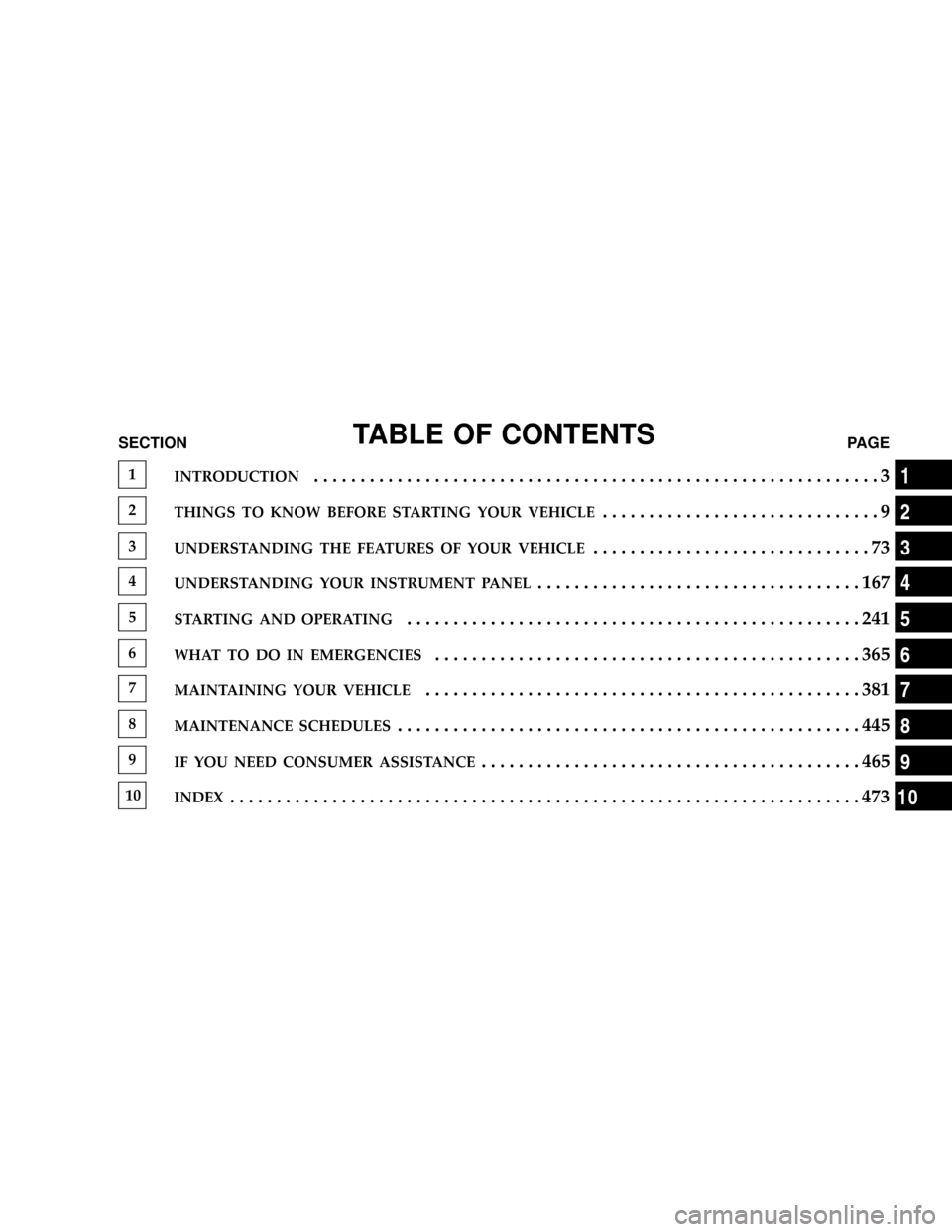
TABLE OF CONTENTSSECTIONPAGE
1INTRODUCTION.............................................................3
2THINGS TO KNOW BEFORE STARTING YOUR VEHICLE..............................9
3UNDERSTANDING THE FEATURES OF YOUR VEHICLE..............................73
4UNDERSTANDING YOUR INSTRUMENT PANEL...................................167
5STARTING AND OPERATING.................................................241
6WHAT TO DO IN EMERGENCIES..............................................365
7MAINTAINING YOUR VEHICLE...............................................381
8MAINTENANCE SCHEDULES..................................................445
9IF YOU NEED CONSUMER ASSISTANCE.........................................465
10INDEX....................................................................473
1
2
3
4
5
6
7
8
9
10
Page 7 of 492
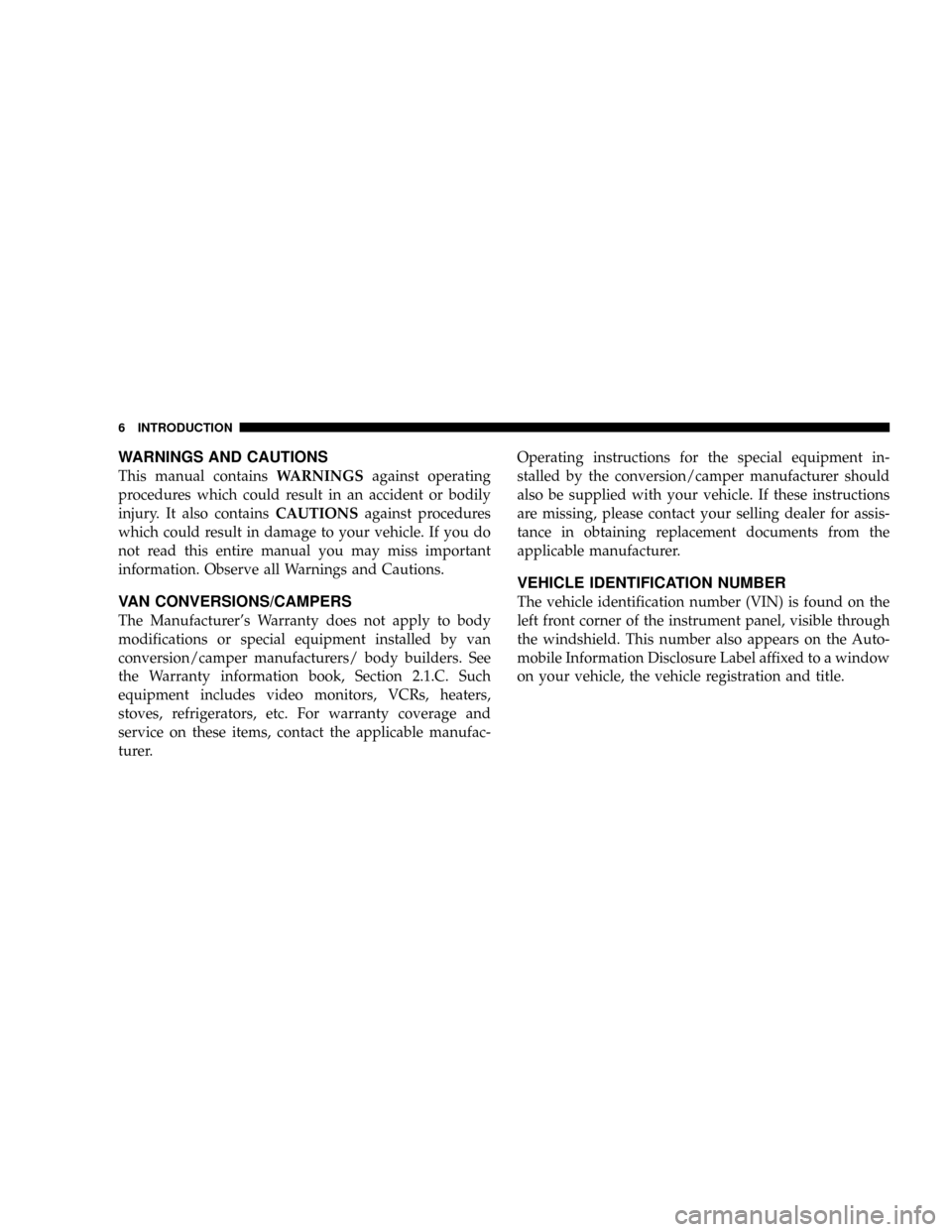
WARNINGS AND CAUTIONS
This manual containsWARNINGSagainst operating
procedures which could result in an accident or bodily
injury. It also containsCAUTIONSagainst procedures
which could result in damage to your vehicle. If you do
not read this entire manual you may miss important
information. Observe all Warnings and Cautions.
VAN CONVERSIONS/CAMPERS
The Manufacturer's Warranty does not apply to body
modifications or special equipment installed by van
conversion/camper manufacturers/ body builders. See
the Warranty information book, Section 2.1.C. Such
equipment includes video monitors, VCRs, heaters,
stoves, refrigerators, etc. For warranty coverage and
service on these items, contact the applicable manufac-
turer.Operating instructions for the special equipment in-
stalled by the conversion/camper manufacturer should
also be supplied with your vehicle. If these instructions
are missing, please contact your selling dealer for assis-
tance in obtaining replacement documents from the
applicable manufacturer.
VEHICLE IDENTIFICATION NUMBER
The vehicle identification number (VIN) is found on the
left front corner of the instrument panel, visible through
the windshield. This number also appears on the Auto-
mobile Information Disclosure Label affixed to a window
on your vehicle, the vehicle registration and title.
6 INTRODUCTION
Page 10 of 492
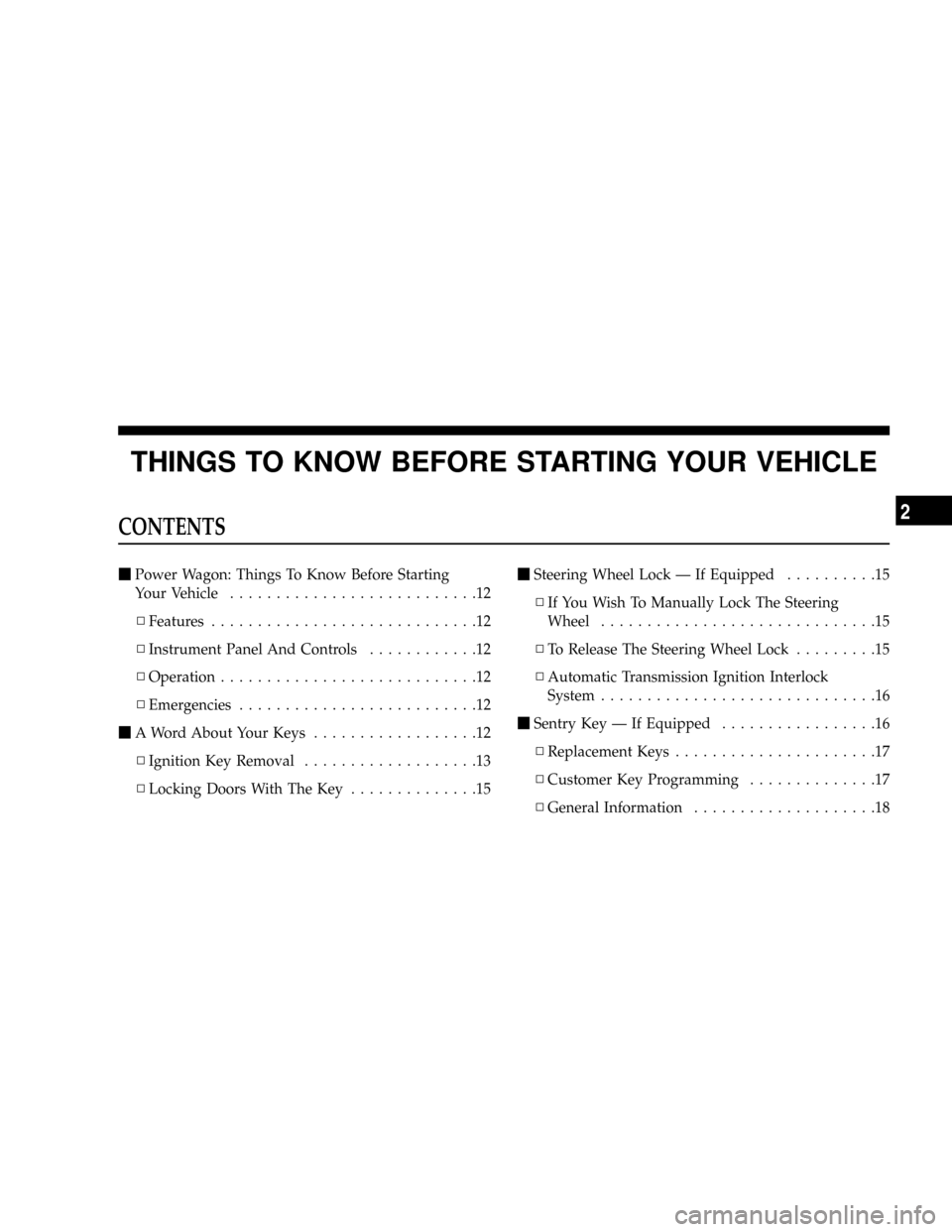
THINGS TO KNOW BEFORE STARTING YOUR VEHICLE
CONTENTS
mPower Wagon: Things To Know Before Starting
Your Vehicle...........................12
NFeatures.............................12
NInstrument Panel And Controls............12
NOperation............................12
NEmergencies..........................12
mA Word About Your Keys..................12
NIgnition Key Removal...................13
NLocking Doors With The Key..............15mSteering Wheel Lock Ð If Equipped..........15
NIf You Wish To Manually Lock The Steering
Wheel..............................15
NTo Release The Steering Wheel Lock.........15
NAutomatic Transmission Ignition Interlock
System..............................16
mSentry Key Ð If Equipped.................16
NReplacement Keys......................17
NCustomer Key Programming..............17
NGeneral Information....................18
2
Page 13 of 492
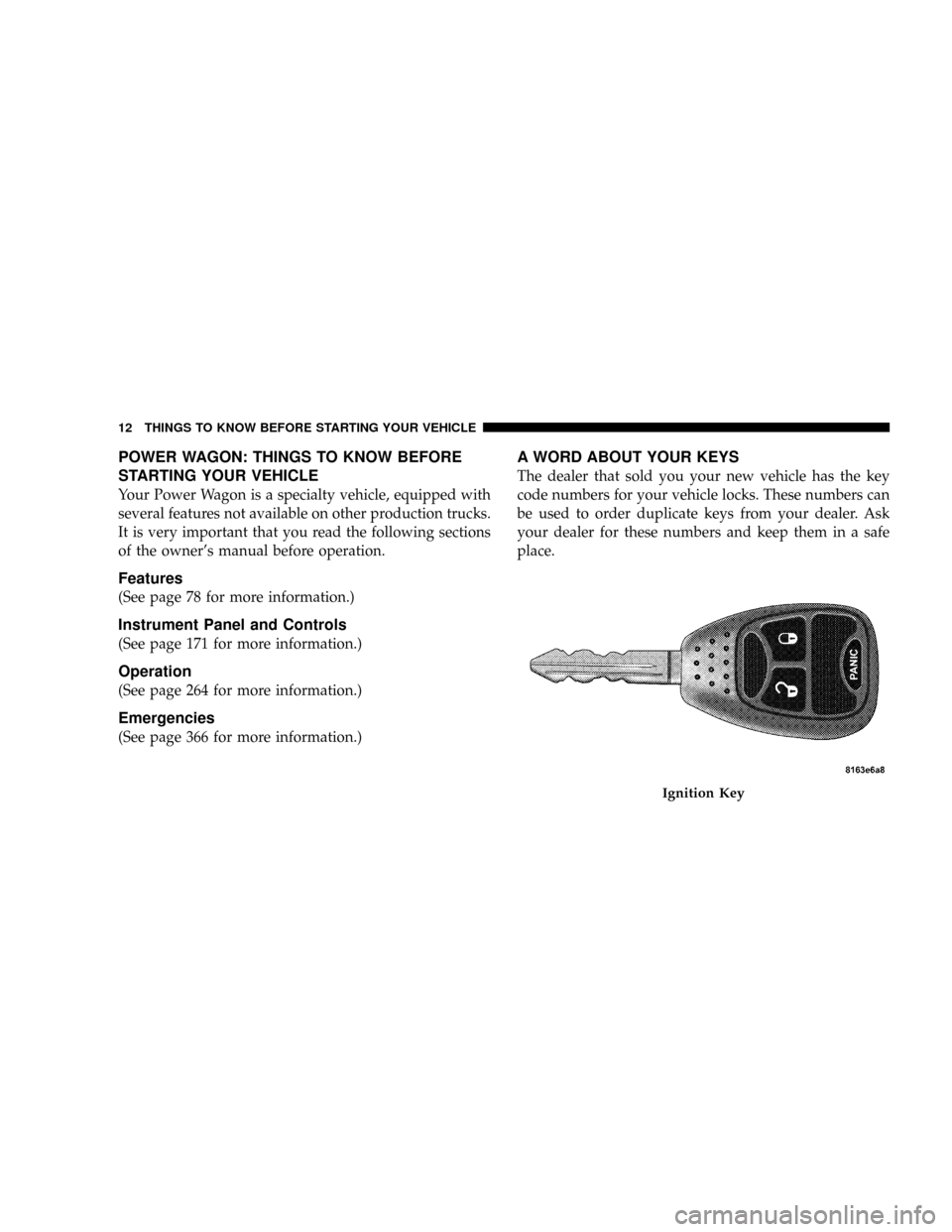
POWER WAGON: THINGS TO KNOW BEFORE
STARTING YOUR VEHICLE
Your Power Wagon is a specialty vehicle, equipped with
several features not available on other production trucks.
It is very important that you read the following sections
of the owner's manual before operation.
Features
(See page 78 for more information.)
Instrument Panel and Controls
(See page 171 for more information.)
Operation
(See page 264 for more information.)
Emergencies
(See page 366 for more information.)
A WORD ABOUT YOUR KEYS
The dealer that sold you your new vehicle has the key
code numbers for your vehicle locks. These numbers can
be used to order duplicate keys from your dealer. Ask
your dealer for these numbers and keep them in a safe
place.
Ignition Key
12 THINGS TO KNOW BEFORE STARTING YOUR VEHICLE
Page 15 of 492
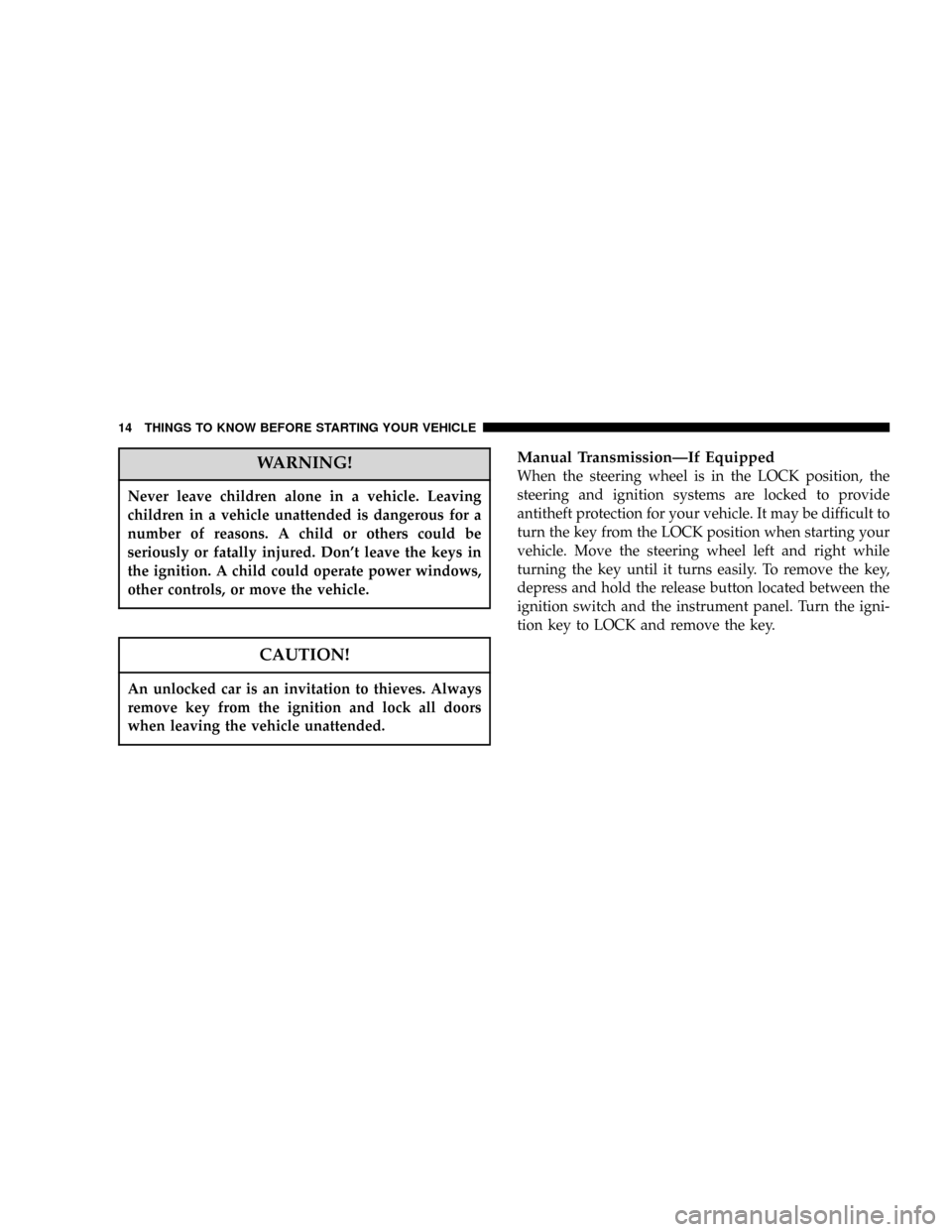
WARNING!
Never leave children alone in a vehicle. Leaving
children in a vehicle unattended is dangerous for a
number of reasons. A child or others could be
seriously or fatally injured. Don't leave the keys in
the ignition. A child could operate power windows,
other controls, or move the vehicle.
CAUTION!
An unlocked car is an invitation to thieves. Always
remove key from the ignition and lock all doors
when leaving the vehicle unattended.
Manual TransmissionÐIf Equipped
When the steering wheel is in the LOCK position, the
steering and ignition systems are locked to provide
antitheft protection for your vehicle. It may be difficult to
turn the key from the LOCK position when starting your
vehicle. Move the steering wheel left and right while
turning the key until it turns easily. To remove the key,
depress and hold the release button located between the
ignition switch and the instrument panel. Turn the igni-
tion key to LOCK and remove the key.
14 THINGS TO KNOW BEFORE STARTING YOUR VEHICLE
Page 20 of 492
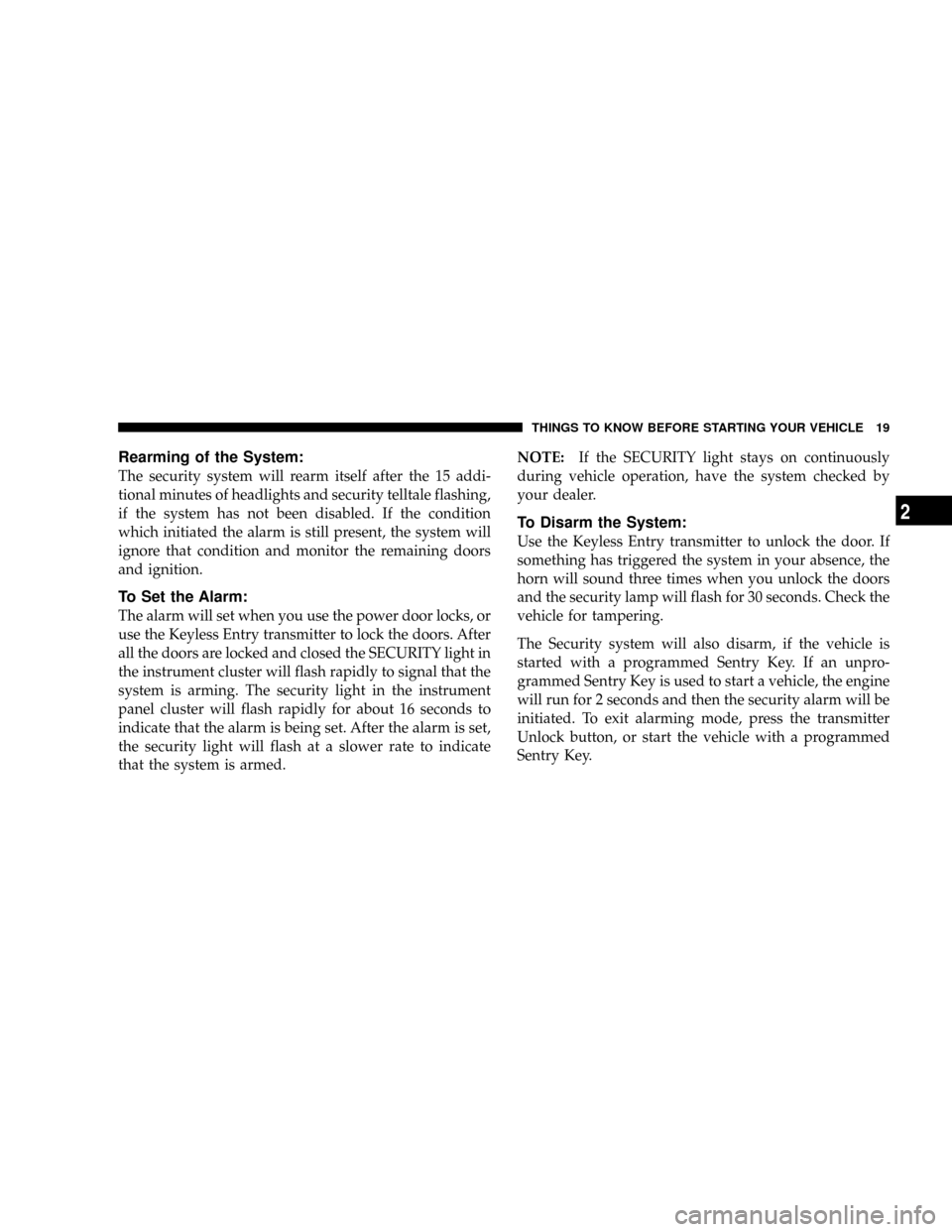
Rearming of the System:
The security system will rearm itself after the 15 addi-
tional minutes of headlights and security telltale flashing,
if the system has not been disabled. If the condition
which initiated the alarm is still present, the system will
ignore that condition and monitor the remaining doors
and ignition.
To Set the Alarm:
The alarm will set when you use the power door locks, or
use the Keyless Entry transmitter to lock the doors. After
all the doors are locked and closed the SECURITY light in
the instrument cluster will flash rapidly to signal that the
system is arming. The security light in the instrument
panel cluster will flash rapidly for about 16 seconds to
indicate that the alarm is being set. After the alarm is set,
the security light will flash at a slower rate to indicate
that the system is armed.NOTE:If the SECURITY light stays on continuously
during vehicle operation, have the system checked by
your dealer.
To Disarm the System:
Use the Keyless Entry transmitter to unlock the door. If
something has triggered the system in your absence, the
horn will sound three times when you unlock the doors
and the security lamp will flash for 30 seconds. Check the
vehicle for tampering.
The Security system will also disarm, if the vehicle is
started with a programmed Sentry Key. If an unpro-
grammed Sentry Key is used to start a vehicle, the engine
will run for 2 seconds and then the security alarm will be
initiated. To exit alarming mode, press the transmitter
Unlock button, or start the vehicle with a programmed
Sentry Key.
THINGS TO KNOW BEFORE STARTING YOUR VEHICLE 19
2
Page 46 of 492
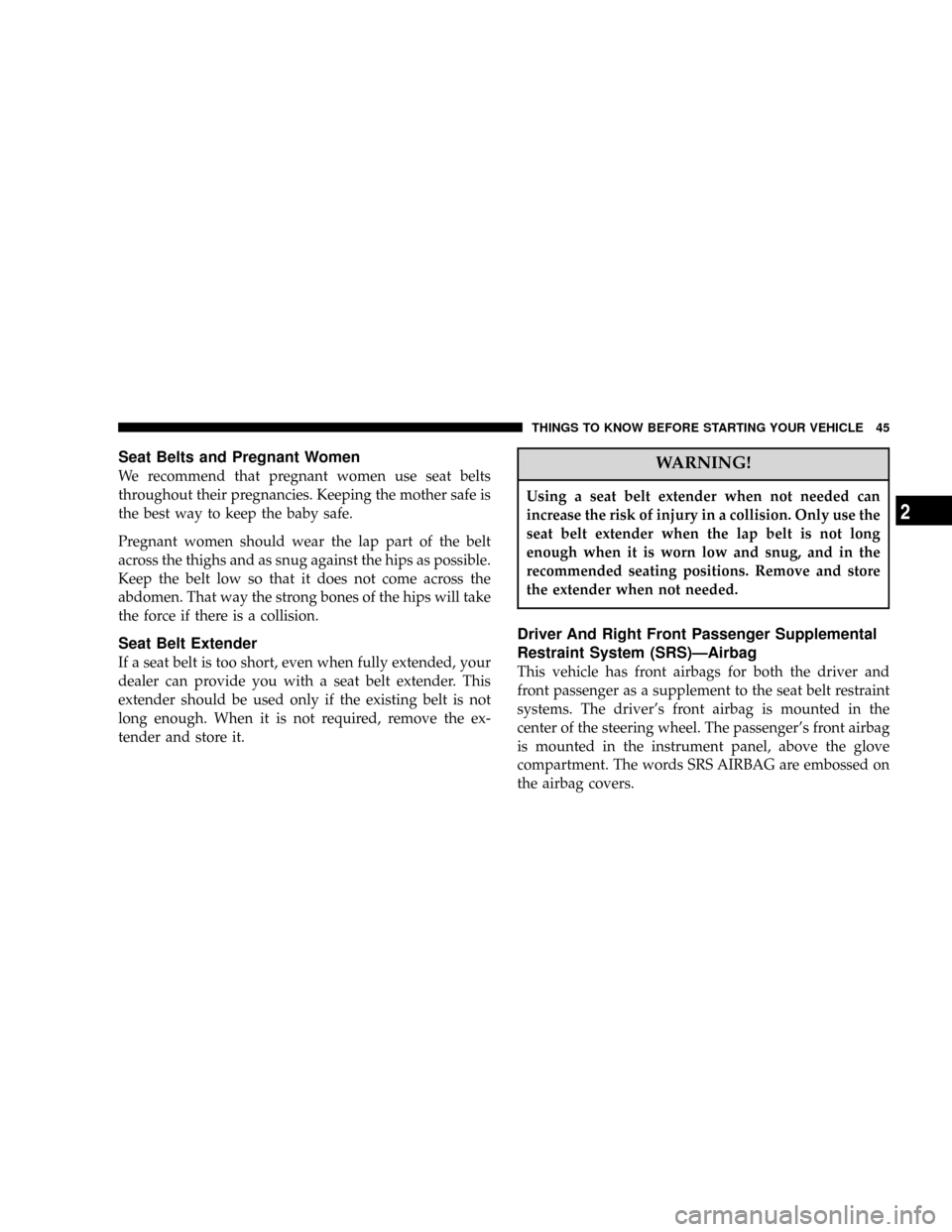
Seat Belts and Pregnant Women
We recommend that pregnant women use seat belts
throughout their pregnancies. Keeping the mother safe is
the best way to keep the baby safe.
Pregnant women should wear the lap part of the belt
across the thighs and as snug against the hips as possible.
Keep the belt low so that it does not come across the
abdomen. That way the strong bones of the hips will take
the force if there is a collision.
Seat Belt Extender
If a seat belt is too short, even when fully extended, your
dealer can provide you with a seat belt extender. This
extender should be used only if the existing belt is not
long enough. When it is not required, remove the ex-
tender and store it.
WARNING!
Using a seat belt extender when not needed can
increase the risk of injury in a collision. Only use the
seat belt extender when the lap belt is not long
enough when it is worn low and snug, and in the
recommended seating positions. Remove and store
the extender when not needed.
Driver And Right Front Passenger Supplemental
Restraint System (SRS)ÐAirbag
This vehicle has front airbags for both the driver and
front passenger as a supplement to the seat belt restraint
systems. The driver's front airbag is mounted in the
center of the steering wheel. The passenger's front airbag
is mounted in the instrument panel, above the glove
compartment. The words SRS AIRBAG are embossed on
the airbag covers.
THINGS TO KNOW BEFORE STARTING YOUR VEHICLE 45
2
Page 48 of 492
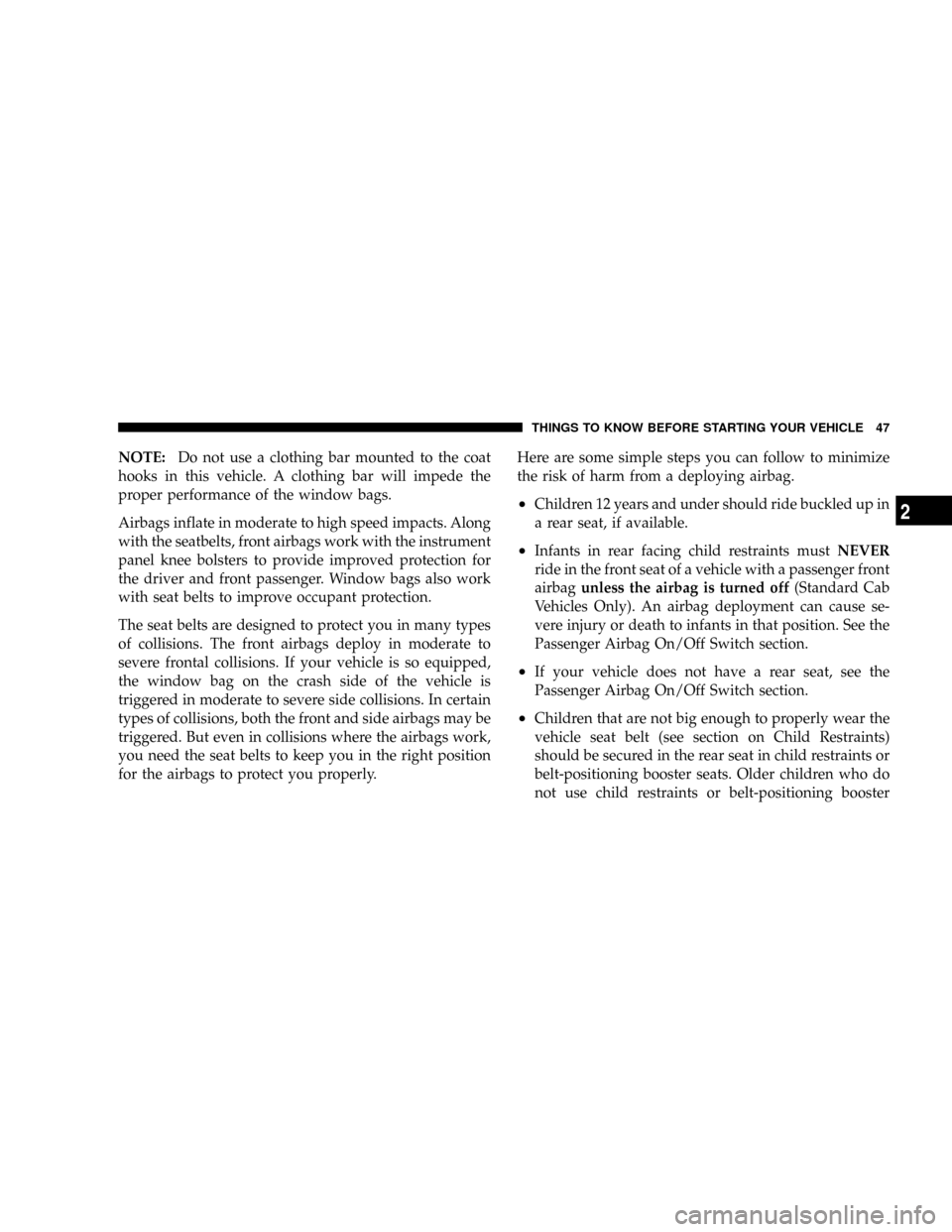
NOTE:Do not use a clothing bar mounted to the coat
hooks in this vehicle. A clothing bar will impede the
proper performance of the window bags.
Airbags inflate in moderate to high speed impacts. Along
with the seatbelts, front airbags work with the instrument
panel knee bolsters to provide improved protection for
the driver and front passenger. Window bags also work
with seat belts to improve occupant protection.
The seat belts are designed to protect you in many types
of collisions. The front airbags deploy in moderate to
severe frontal collisions. If your vehicle is so equipped,
the window bag on the crash side of the vehicle is
triggered in moderate to severe side collisions. In certain
types of collisions, both the front and side airbags may be
triggered. But even in collisions where the airbags work,
you need the seat belts to keep you in the right position
for the airbags to protect you properly.Here are some simple steps you can follow to minimize
the risk of harm from a deploying airbag.
²Children 12 years and under should ride buckled up in
a rear seat, if available.
²Infants in rear facing child restraints mustNEVER
ride in the front seat of a vehicle with a passenger front
airbagunless the airbag is turned off(Standard Cab
Vehicles Only). An airbag deployment can cause se-
vere injury or death to infants in that position. See the
Passenger Airbag On/Off Switch section.
²If your vehicle does not have a rear seat, see the
Passenger Airbag On/Off Switch section.
²Children that are not big enough to properly wear the
vehicle seat belt (see section on Child Restraints)
should be secured in the rear seat in child restraints or
belt-positioning booster seats. Older children who do
not use child restraints or belt-positioning booster
THINGS TO KNOW BEFORE STARTING YOUR VEHICLE 47
2
Page 49 of 492
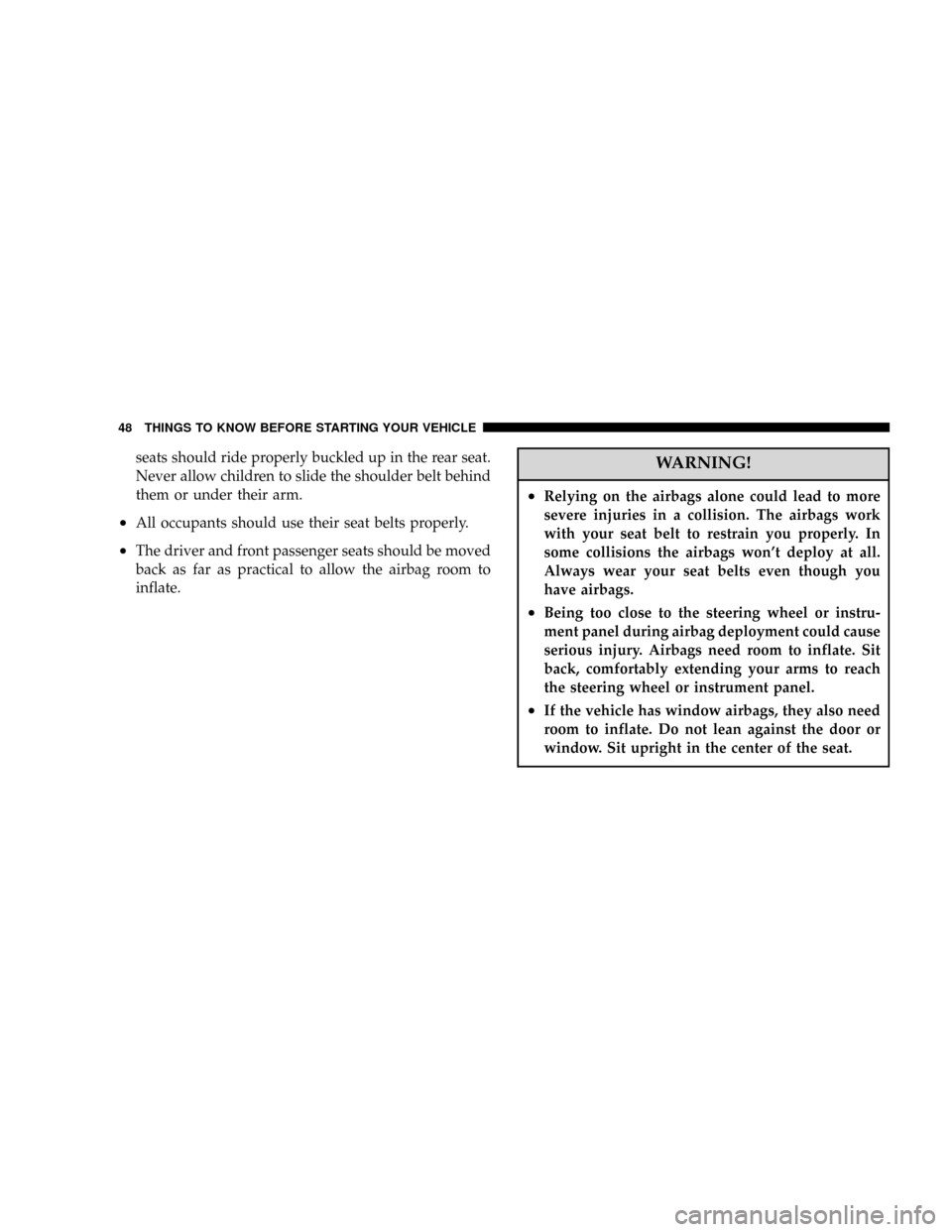
seats should ride properly buckled up in the rear seat.
Never allow children to slide the shoulder belt behind
them or under their arm.
²All occupants should use their seat belts properly.
²The driver and front passenger seats should be moved
back as far as practical to allow the airbag room to
inflate.
WARNING!
²Relying on the airbags alone could lead to more
severe injuries in a collision. The airbags work
with your seat belt to restrain you properly. In
some collisions the airbags won't deploy at all.
Always wear your seat belts even though you
have airbags.
²Being too close to the steering wheel or instru-
ment panel during airbag deployment could cause
serious injury. Airbags need room to inflate. Sit
back, comfortably extending your arms to reach
the steering wheel or instrument panel.
²If the vehicle has window airbags, they also need
room to inflate. Do not lean against the door or
window. Sit upright in the center of the seat.
48 THINGS TO KNOW BEFORE STARTING YOUR VEHICLE
Page 50 of 492
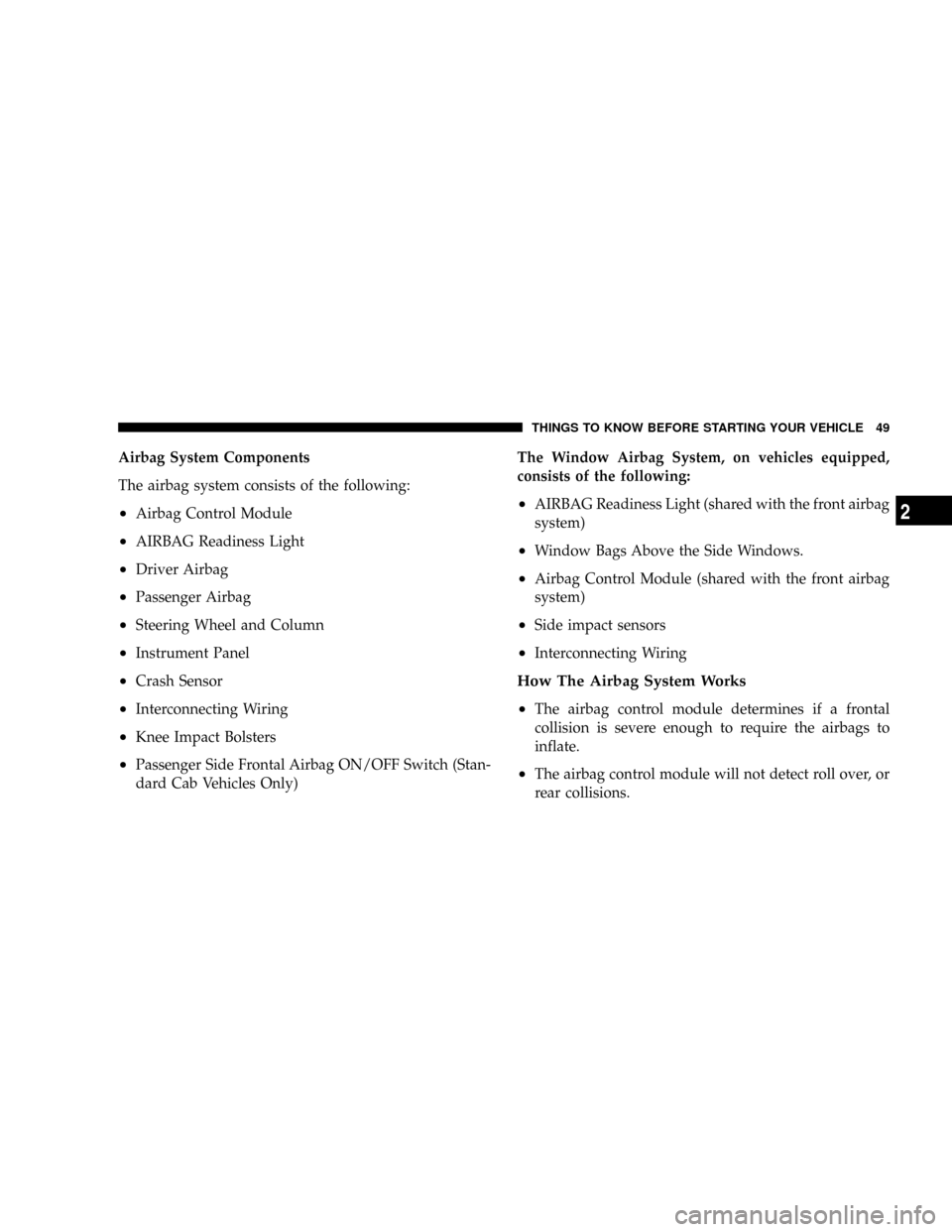
Airbag System Components
The airbag system consists of the following:
²Airbag Control Module
²AIRBAG Readiness Light
²Driver Airbag
²Passenger Airbag
²Steering Wheel and Column
²Instrument Panel
²Crash Sensor
²Interconnecting Wiring
²Knee Impact Bolsters
²Passenger Side Frontal Airbag ON/OFF Switch (Stan-
dard Cab Vehicles Only)The Window Airbag System, on vehicles equipped,
consists of the following:
²AIRBAG Readiness Light (shared with the front airbag
system)
²Window Bags Above the Side Windows.
²Airbag Control Module (shared with the front airbag
system)
²Side impact sensors
²Interconnecting Wiring
How The Airbag System Works
²
The airbag control module determines if a frontal
collision is severe enough to require the airbags to
inflate.
²The airbag control module will not detect roll over, or
rear collisions.
THINGS TO KNOW BEFORE STARTING YOUR VEHICLE 49
2